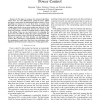Free Online Productivity Tools
i2Speak
i2Symbol
i2OCR
iTex2Img
iWeb2Print
iWeb2Shot
i2Type
iPdf2Split
iPdf2Merge
i2Bopomofo
i2Arabic
i2Style
i2Image
i2PDF
iLatex2Rtf
Sci2ools
ICC
2009
IEEE
2009
IEEE
Cost and Target-Based Scheduling for Switch Power Control
—In this paper we propose two advanced algorithms which allow for both differentiated quality-of-service (QOS) and power conservation in input-queued packet switches. These algorithms are based on two core ideas: first, we assume that the switch can operate in a number of operational speed modes; a higher speed mode serves more packets per time slot at the cost of higher power consumption. Second, each virtual output queue may tolerate a certain low backlog which is called a target in this setting. Thus, one can control power by adjusting the speed mode and QOS by setting the targets appropriately. We first survey previous work to provide the necessary background behind our approach. We then describe our algorithms and evaluate their performance experimentally through simulation. Our preliminary results show that these new procedures offer significant performance gains compared to existing approaches.
| Added | 21 May 2010 |
| Updated | 21 May 2010 |
| Type | Conference |
| Year | 2009 |
| Where | ICC |
| Authors | Benjamin Yolken, Dimitrios Tsamis, Nicholas Bambos |
Comments (0)

